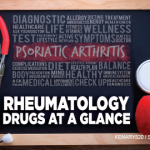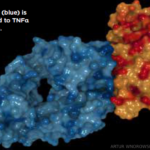- Fatal hepatosplenic T cell lymphoma (HSTCL) has occurred postmarketing in adolescent and young adult inflammatory bowel disease (IBD) patients treated with TNFi’s.
Warnings & Precautions
- Do not start adalimumab during an active infection. If an infection develops, monitor carefully, and stop adalimumab if the infection becomes serious.
- Invasive fungal infections—for patients who develop a systemic illness on adalimumab, consider empiric anti-fungal therapy for those who reside in or travel to regions where mycoses are endemic.
- The incidence of malignancies was greater in adalimumab-treated patients than in the control groups.
- Anaphylaxis or serious allergic reactions may occur.
- Hepatitis B virus (HBV) reactivation can occur. Monitor HBV carriers during and several months after therapy. If reactivation occurs, stop adalimumab and begin anti-viral therapy.
- Demyelinating disease exacerbation, or new onset, may occur.
- Cytopenias, pancytopenia—advise patients to seek immediate medical attention if they develop signs and symptoms suggestive of blood dyscrasias or infection (e.g., persistent fever, bruising, bleeding, pallor) while on adalimumab. Consider discontinuation of therapy in patients with confirmed significant hematologic abnormalities.
- Heart failure, worsening or new onset, may occur.
- Lupus-like syndrome—stop adalimumab if syndrome develops.
Dosage & Administration
Adalimumab is administered by subcutaneous injection. The recommended dose is an initial dose of 80 mg, followed by 40 mg every other week starting one week after the initial dose.
Commentary: The approval of adalimumab for plaque psoriasis was based on two pivotal clinical trials that had enrolled more than 1,400 patients. Nearly three in four patients achieved at least a PASI 75 at Week 16 of treatment vs. placebo. The most common adverse reactions (≥10%) are infections (e.g., upper respiratory, sinusitis), injection-site reactions, headache and rash.
Certolizumab pegol (Cimzia):14 injection
Drug class: DMARD, TNFi
Boxed warning: Refer to *ISI (above)
Warnings & Precautions
- Do not start certolizumab during an active infection. If an infection develops, monitor carefully, and stop certolizumab if the infection becomes serious.
- Invasive fungal infections—for patients who develop a systemic illness on certolizumab, consider empiric anti-fungal therapy for those who reside in or travel to regions where mycoses are endemic.
- Cases of lymphoma and other malignancies have been observed in patients receiving TNFi’s.
- Heart failure, worsening or new onset, may occur.
- Anaphylaxis or serious allergic reactions may occur.
- HBV reactivation can occur. Test for HBV infection before starting certolizumab. Monitor HBV carriers during and several months after therapy. If reactivation occurs, stop certolizumab and begin anti-viral therapy.
- Demyelinating disease, exacerbation or new onset, may occur.
- Cytopenias, pancytopenia—advise patients to seek immediate medical attention if symptoms develop, and consider stopping certolizumab.
- Lupus-like syndrome—stop certolizumab if syndrome develops.
Dosage & Administration
Certolizumab is administered by subcutaneous injection. The recommended initial dose is 400 mg (given as two subcutaneous injections of 200 mg) every other week. For some patients (with body weight ≤90 kg), a dose of 400 mg (given as two subcutaneous injections of 200 mg each) initially and at Weeks 2 and 4, followed by 200 mg every other week may be considered.
Commentary: The U.S. Food and Drug Administration (FDA) approval was based on three clinical trials that enrolled over 1,000 patients. The results showed that patients had significant improvement in psoriasis symptoms through Week 48 in adults who received certolizumab compared with placebo. The most common adverse reactions (≥7%) are upper respiratory tract infection, rash and urinary tract infection.



